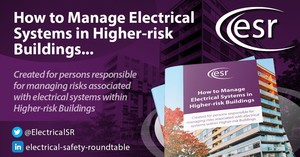
Jon has extensive experience of working within construction competence and certification and is a current member of the Building Regulations Advisory Committee (BRAC), supporting government on building safety reforms.
My hope for the new Building Safety Regulator is that it takes its place firmly in leading the reforms required to ensure that when residents go to sleep, they do so knowing that the building they are in is safe for them and their family.
The BSR needs to deliver a policy of greater oversight across all buildings, increased competence among the construction industry and clear accountability so that those creating the risk, will be required to manage the risk.
As chair of the Interim Industry Competence Committee (IICC), I will drive forward the committee to establish a strategic overview of competence, deliver a clear leadership role, and become the authoritative voice of competence in industry. IICC will create a baseline position of competence and a clear pathway for the next 5-7 years so that the BSR and other stakeholders can judge progress and impact. We will also ensure the formal statutory Industry Competence Committee is established, so that when it forms it does so with a clear road ahead, active working relationships with key stakeholders and a solid momentum behind it.
Whilst the committee is advisory, it can and will present challenge and guidance when required. This will be particularly relevant in areas identified as weak, where obvious gaps appear and where any issues or incidents arise. Our role is high-level but through our ability to form sub-committees we can review areas that are not already being addressed, help others to take action, and offer a supporting guidance role.
Whilst there is a lot to do, and we should not underestimate the challenge, we intend to deliver a clear and focused impact on establishing competency frameworks that can translate well to all sides of industry.
|

The Electrical Safety Roundtable (ESR) has published new guidance on managing risks associated with electrical systems in higher-risk buildings (HRBs).
The ESR is a leading industry forum, providing research and policy solutions to government and industry.
‘How to manage electrical systems within higher-risk buildings’ has been created in collaboration with over 25 organisations with expertise in this sector. It is designed to support industry to review its current practices around managing and maintaining electrical systems in HRBs and consider how they can improve for the safety of residents.
Peter Baker, Chief Inspector of Buildings said:
“Making high-rise buildings safer for residents is about understanding what can go wrong, how it can lead to a fire or structural problem, and what needs to be in place to prevent a serious incident and reduce its impact on people. Measures include having electrical and other building systems properly designed, installed, and maintained by competent people, and making sure safety systems work when you need them.
“The ESR guide is a welcome example of how industry has taken the initiative and is sharing the knowledge, experience and expertise of a number of organisations to help those responsible for the safety of high-rise buildings manage electrical safety risks, and prepare for when the building safety reforms become law”.
Read 'How to manage electrical systems within higher-risk buildings'
|
HSE has published a report identifying serious incident scenarios for high-rise residential buildings, and potential control measures.
As part of the reforms to the building safety system a Joint Regulators’ group (JRG), which includes HSE, is assisting in the transition to the proposed new regulatory framework. This report describes research, done in 2019, for the JRG.
Read 'Residential high rise: Serious incident scenarios'

The Industry Safety Steering Group (ISSG) was established more than 3 years ago, very soon after the publication of my final report – Building a Safer Future.
The purpose of the group is to drive culture change within all parts of the industry to deliver on the recommendations of my report and to act ahead of legislation. The group comprises senior leaders from a variety of backgrounds, some of whom know the built environment well but also people with a wealth of experience from other sectors who have previously travelled the path of delivering culture change, often in the wake of disasters/crises.
In the coming days the third Annual Report from ISSG will be published and it will show a mixed picture. We have heard in the last year from some impressive organisations who have recognised the need for change and who speak very positively about the benefits they have seen from implementing new ways of working which will meet the needs of the new regulatory regime – and even in some cases go beyond it. I have written here previously about the great progress which has been made with the Building a Safer Future Charter and the Code for Construction Product Information and we are now seeing leading organisations sign up and make a serious commitment.
But the report isn’t all good news. We are still seeing too many organisations who are holding back from taking action often combined with poor excuses for their inertia. Time - and patience – is running out for the laggards in the system. It is time for the leaders to be recognised for what they are doing and for those who choose to wait or hide to be clearly identified, whilst at the same time continuing to provide them with evidence that the new regime is coming, and they must prepare.
More than 20 years ago it took a high-profile industry summit meeting to drive a shift in attitudes to workplace health and safety in construction. The ISSG firmly believes that a similar approach is needed to make a significant shift in the pace of change on building safety.
|
The British Standards Institution (BSI) is the UK national standards body. Last year, BSI started work on the 'Built Environment Competence Programme'. This industry-led programme aims to raise the standards of workforce competence across the built environment.
In the latest of its consultations supporting the Building Safety Bill, BSI is seeking comments on a competence framework for the role of principal contractor. A principal contractor is the contractor with control over the construction phase of a project involving more than one contractor.
The framework defines the proposed competence and commitment of individual principal contractors working on all buildings to identify, plan, monitor and manage building safety risks during the construction phase and promote safer work practices.
They need the views of people who work in the housing, construction, fire, and safety industries.
Download and comment on the draft framework
We’d like to know what you think about this eBulletin.
If you have any comments or feedback to help us tailor information and updates to meet your needs please email BSR-communications@hse.gov.uk
|